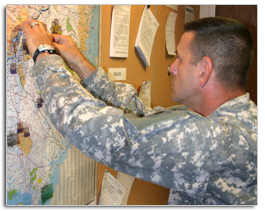 |
If Guard Soldiers and Airmen are going to respond swiftly to meet the humanitarian and safety needs of Garden State citizens as a result of a hurricane striking the East Coast, they need to exercise personnel and equipment.
 |
Sgt. 1st Class Steven Katkics Jr., updates a map during Operation Blue Lightning. Photo by Spc. William Addison, 444MPAD |
Soldiers from the New Jersey Army National Guard huddled around computer screens at the Joint Training and Training Development Center, Fort Dix, to track their responses and hone their state emergency plan that focused on New Jersey in the event the governor declares a state of emergency.
According to the scenario, the National Weather Service reports Hurricane Zelda was scheduled to hit the East Coast, but weather models are unclear of the impact. It was estimated that there would be up to 20 inches of rainfall, with sustained winds that at a best case scenario were to be 80 miles per hour. High winds and coastal flooding were likely to create power outages and poor road conditions.
This was all part of a weekend-long exercise called Operation Blue Lightning. The purpose of the exercise was to track the results of the New Jersey National Guard under its new configuration of units expected to come online Oct. 1 as a result of the Guard’s recent transformation, various participants in the 48-hour long exercise explained.
To ensure the Guard meets the needs of the New Jersey Office of Emergency Management (OEM), the Guard levied three major support commands and subordinate units to practice their emergency management skills at the center.
Soldiers sitting inside assigned unit designated cubicles, under the sign “All But War is Simulation,” poured over maps, tracked unit personnel, vehicles and equipment assets on computer screens to ensure mission success.
“If you look across the floor right now each cubicle simulates an armory, personnel, motor pool and drill floor,” said Master Sgt. Karl Tomaszewski.
“As a mission is handed down to the unit from the OEM, we then track the progress of the mission on the screen.
We can then track (for example) a vehicle and its progress to provide emergency support needed in a specific part of the state.”
At the center, Maj. Robert Ryan was serving as the National Guard liaison officer, who would be assigned to the New Jersey State Police OEM operation. As the liaison officer, his role is to validate county requests for emergency support once they are received from the New Jersey State Police’s OEM.
“I have to review all these requirements to ensure we can support the request. For example, a county has to exhaust all their emergency resources before they get to us. Once the request is approved by OEM, I then turn it over to the Guard’s Joint Operations Center where it then begins becoming resourced,” he said.
Some of the requirements Soldiers and Airmen could face during an emergency include military police support for traffic control, transportation and military equipment usage.
Future exercises will continue to test and improve the New Jersey National Guard so that when a hurricane does strike the East Coast, the state’s Citizen Soldiers and Airmen will be able to swiftly meet the humanitarian and safety needs of Garden State citizens.
 |
Volume 32 Number 5 Staff / Information |
|
 |